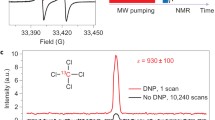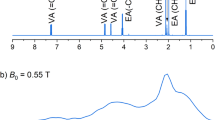Abstract
Object
The PASADENA method has achieved hyperpolarization of 16–20% (exceeding 40,000-fold signal enhancement at 4.7 T), in liquid samples of biological molecules relevant to in vivo MRI and MRS. However, there exists no commercial apparatus to perform this experiment conveniently and reproducibly on the routine basis necessary for translation of PASADENA to questions of biomedical importance. The present paper describes equipment designed for rapid production of six to eight liquid samples per hour with high reproducibility of hyperpolarization.
Materials and methods
Drawing on an earlier, but unpublished, prototype, we provide diagrams of a delivery circuit, a laminar-flow reaction chamber within a low field NMR contained in a compact, movable housing. Assembly instructions are provided from which a computer driven, semi-automated PASADENA polarizer can be constructed.
Results
Together with an available parahydrogen generator, the polarizer, which can be operated by a single investigator, completes one cycle of hyperpolarization each 52 s. Evidence of efficacy is presented. In contrast to competing, commercially available devices for dynamic nuclear polarization which characteristically require 90 min per cycle, PASADENA provides a low-cost alternative for high throughput.
Conclusions
This equipment is suited to investigators who have an established small animal NMR and wish to explore the potential of heteronuclear (13 C and 15 N) MRI, MRS, which harnesses the enormous sensitivity gain offered by hyperpolarization.
Similar content being viewed by others
References
Gillard JH, Waldman AD, Barker PB (2005) Clinical MR neuroimaging: diffusion, perfusion and spectroscopy. Cambridge University Press, New York, NY
Albert MS, Cates GD, Driehuys B, Happer W, Saam B, Springer CS, Wishnia A (1994) Biological magnetic-resonance-imaging using laser polarized Xe-129. Nature 370: 199–201
Ardenkjaer-Larsen JH, Fridlund B, Gram A, Hansson G, Hansson L, Lerche MH, Servin R, Thaning M, Golman K (2003) Increase in signal-to-noise ratio of >10,000 times in liquid-state NMR. Proc Natl Acad Sci USA 100: 10158–10163
Bowers CR, Weitekamp DP (1987) Para-hydrogen and synthesis allow dramatically enhanced nuclear alignment. J Am Chem Soc 109: 5541–5542
Kuhn LT, Bargon J (2007) Transfer of parahydrogen-induced hyperpolarization to heteronuclei. Top Curr Chem 276: 25–68
Golman K, Axelsson O, Johannesson H, Mansson S, Olofsson C, Petersson JS (2001) Parahydrogen-induced polarization in imaging: subsecond C-13 angiography. Magn Reson Med 46: 1–5
Hövener JB, Chekmenev EY, Norton VA, Harris K, Perman WH, Weitekamp DP, Bhattacharya P (2007) Quality assurance of PASADENA hyperpolarization for 13 C biomolecules. Magn Reson Mater Phy (in press). doi:10.1007/s10334-008-0154-y
Goldman M, Johannesson H (2005) Conversion of a proton pair para order into C-13 polarization by rf irradiation for use in MRI. C R Physique 6: 575–581
Goldman M, Johannesson H, Axelsson O, Karlsson M (2006) Design and implementation of C-13 hyperpolarization from para-hydrogen for new MRI contrast agents. C R Chimie 9: 357–363
Tam S, Fajardo ME (1999) Ortho/para hydrogen converter for rapid deposition matrix isolation spectroscopy. Rev Sci Instrum 70: 1926–1932
Goldman M, Johannesson H, Axelsson O, Karlsson M (2005) Hyperpolarization of C-13 through order transfer from parahydrogen: a new contrast agent for MRI. Magn Reson Imaging 23: 153–157
Bhattacharya P, Harris K, Lin AP, Mansson M, Norton VA, Perman WH, Weitekamp DP, Ross BD (2005) Ultra-fast three dimensional imaging of hyperpolarized C-13 in vivo. Magn Reson Mater Phys 18: 245–256
Chekmenev E, Hövener JB, Norton VA, Harris K, Batchelder LS, Bhattacharya P, Ross BD, Weitekamp DP (2008) PASADENA hyperpolarization of succinic acid for MRI and MRS. J Am Chem Soc 130: 4212–4213
Ross B, Lin A, Harris K, Bhattacharya P, Schweinsburg B (2003) Clinical experience with C-13 MRS in vivo. NMR Biomed 16: 358–369
Bouchard L, Burt S, Anwar M, Kovtunov K, Koptzug I, Pines A (2008) NMR imaging of catalytic reactions in microreactors with the use of para-hydrogen. Science 319: 442–445
Author information
Authors and Affiliations
Corresponding author
Rights and permissions
About this article
Cite this article
Hövener, JB., Chekmenev, E.Y., Harris, K.C. et al. PASADENA hyperpolarization of 13C biomolecules: equipment design and installation. Magn Reson Mater Phy 22, 111–121 (2009). https://doi.org/10.1007/s10334-008-0155-x
Received:
Revised:
Accepted:
Published:
Issue Date:
DOI: https://doi.org/10.1007/s10334-008-0155-x




